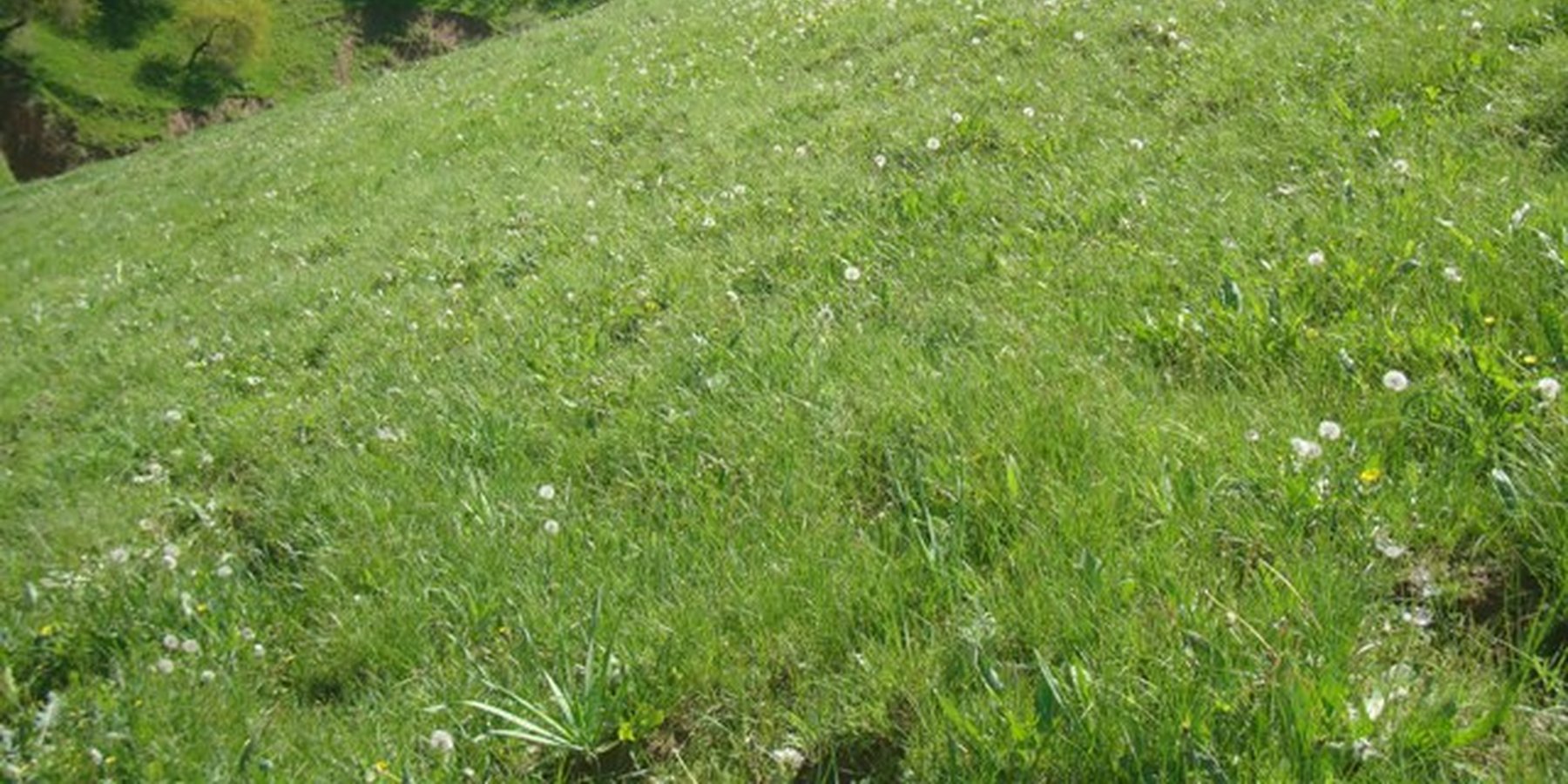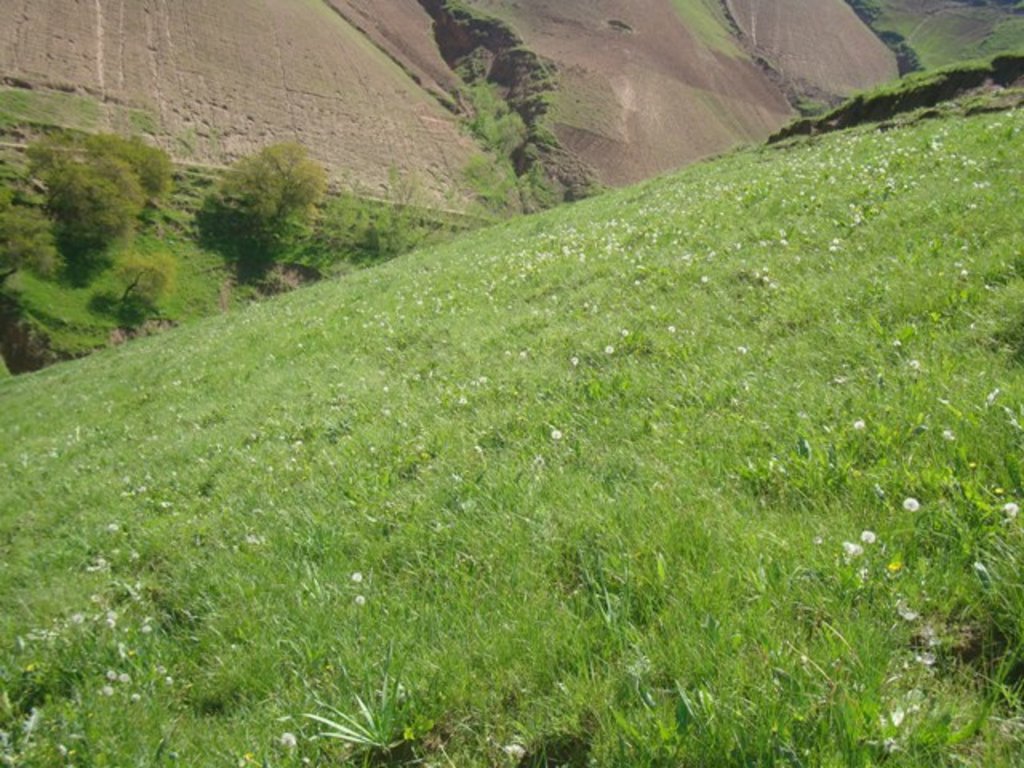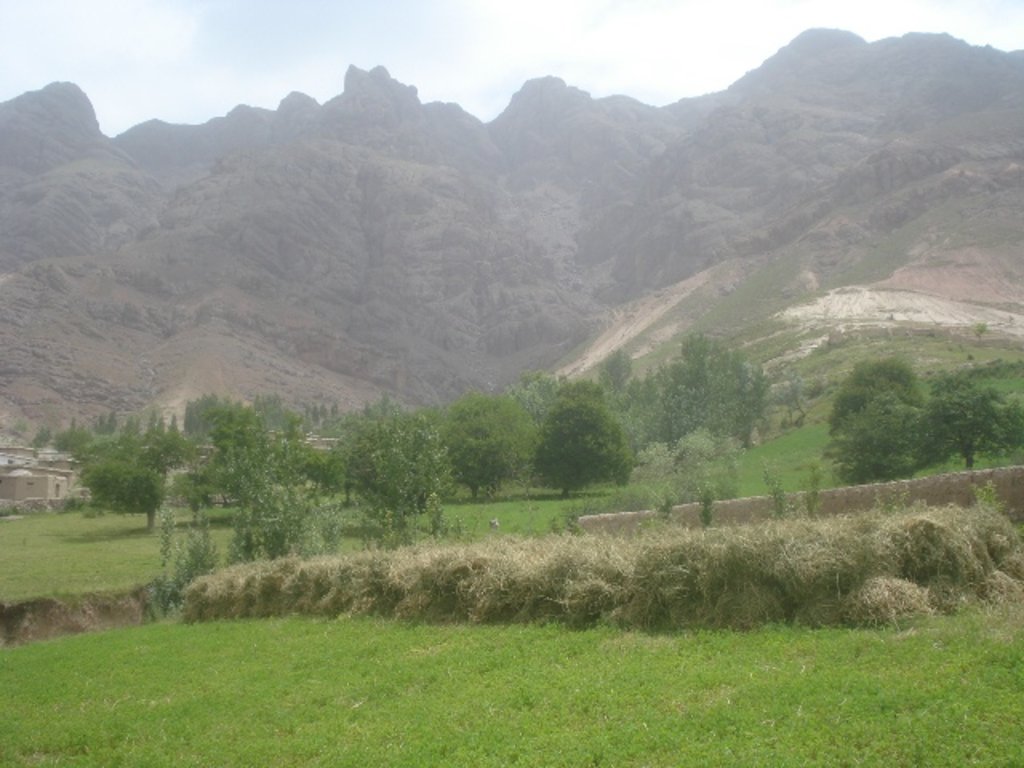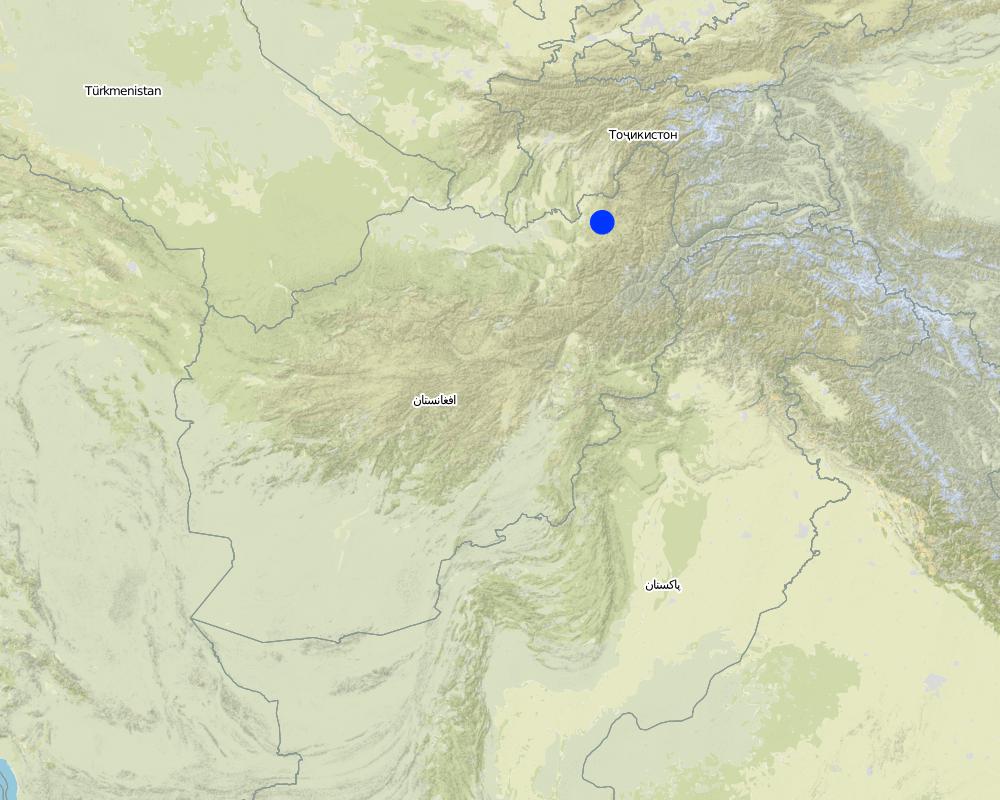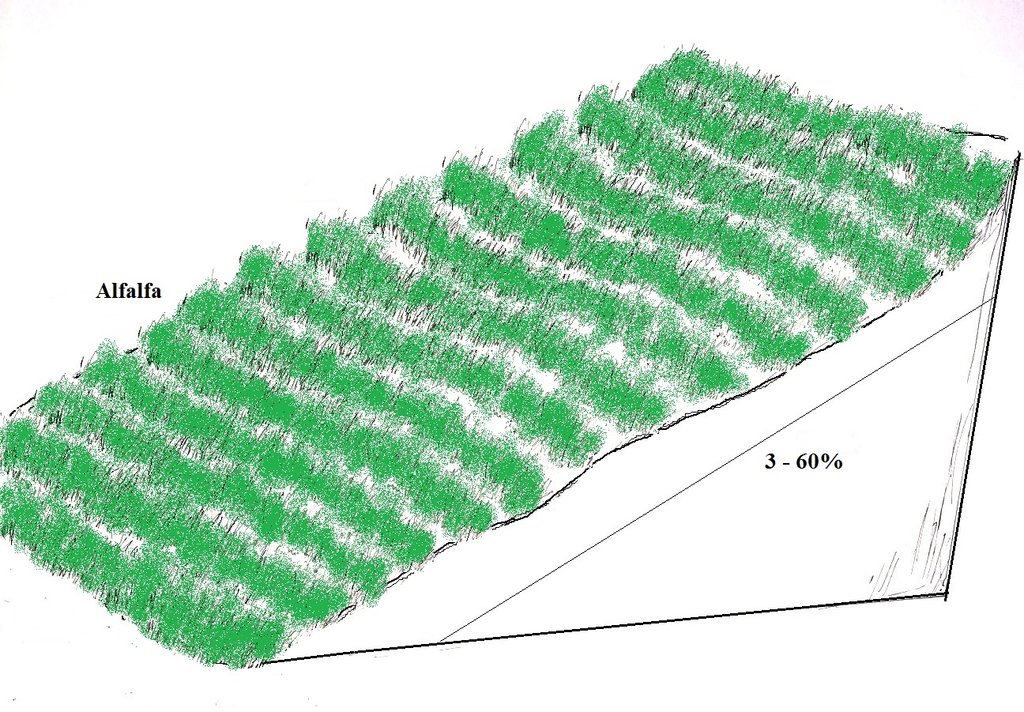Rehabilitation of degraded pastures with alfalfa [Afghanistan]
- Creation:
- Update:
- Compiler: Bettina Wolfgramm
- Editor: Roziya Kirgizbekova
- Reviewers: Rima Mekdaschi Studer, Alexandra Gavilano
Ehyoye charogoh bo posheedani tukhmi reshqa
technologies_672 - Afghanistan
View sections
Expand all Collapse all1. General information
1.2 Contact details of resource persons and institutions involved in the assessment and documentation of the Technology
SLM specialist:
Researcher:
Name of project which facilitated the documentation/ evaluation of the Technology (if relevant)
Livelihood Improvement Project Takhar, Afghanistan (LIPT)Name of project which facilitated the documentation/ evaluation of the Technology (if relevant)
Potential and limitations for improved natural resource management (NRM) in mountain communities in the Rustaq district, Afghanistan (Rustaq NRM Study)Name of the institution(s) which facilitated the documentation/ evaluation of the Technology (if relevant)
Terre des Hommes (Terre des Hommes) - SwitzerlandName of the institution(s) which facilitated the documentation/ evaluation of the Technology (if relevant)
Swiss Agency for Development and Cooperation (DEZA / COSUDE / DDC / SDC) - SwitzerlandName of the institution(s) which facilitated the documentation/ evaluation of the Technology (if relevant)
Bern University of Applied Sciences, School of Agricultural, Forest and Food Sciences (HAFL) - SwitzerlandName of the institution(s) which facilitated the documentation/ evaluation of the Technology (if relevant)
CDE Centre for Development and Environment (CDE Centre for Development and Environment) - Switzerland1.3 Conditions regarding the use of data documented through WOCAT
The compiler and key resource person(s) accept the conditions regarding the use of data documented through WOCAT:
Yes
1.4 Declaration on sustainability of the described Technology
Is the Technology described here problematic with regard to land degradation, so that it cannot be declared a sustainable land management technology?
No
Comments:
SLM practices documented in the frame of the Rustaq NRM study were established only recently (1-3 years ago). It is too early for a final judgment on the sustainability of these technologies within the human and natural environment of Chokar watershed.
1.5 Reference to Questionnaire(s) on SLM Approaches (documented using WOCAT)
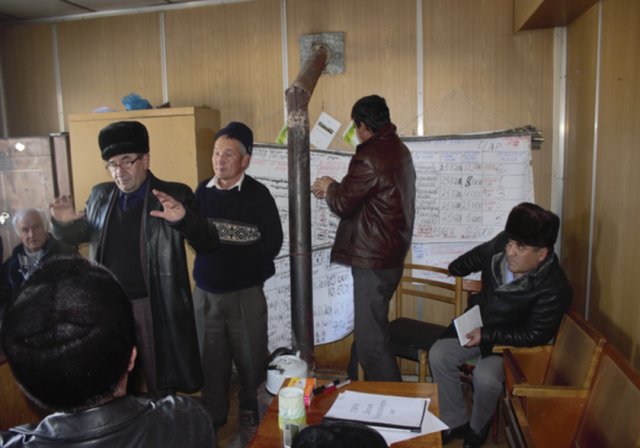
Pasture and Livestock Management Plan [Tajikistan]
"Pasture and Livestock Management Plan" is a participatory approach which is guiding pasture users, members of Pasture User Unions and Pasture User Groups to develop their action plan on pasture and livestock management. The approach brings together stakeholders, who are involved at any stage in pasture management or can contribute …
- Compiler: Askarsho Zevarshoev
2. Description of the SLM Technology
2.1 Short description of the Technology
Definition of the Technology:
Degraded pastures are restored with alfalfa through broad seeding method. The area is put under quarantine for three years to allow for the pasture to restore sufficiently.
2.2 Detailed description of the Technology
Description:
Project supported pasture rehabilitation has taken place in the villages Sari Joy, Jawaz Khana and Dashti Mirzai, located in Chokar watershed of Rustaq District in Northern Afghanistan. The Chokar watershed is a mountainous area situated between 600 - 2,500 m above sea level. The climate is semi-arid with harsh and cold weather in winter and hot and dry summers. The annual precipitation in average years is 580mm. Land degradation affects all forms of land use and includes low vegetation cover, heavy top soil erosion from water, and poor soil fertility. Unsustainable agricultural practices, over-exploitation and high pressure on the natural resources are adversely impacting on the socio-economic well-being of local communities as well as contributing to the risk for being adversely affected by drought as well as landslides and flash foods triggered by heavy rainfall. The data used for the documentation of the technology is based on field research conducted in Chokar watershed, namely in the villages: Sari Joy, Jawaz Khana and Dashti Mirzai. These villages represent the upper, the middle and the lower zone of Chokar watershed, respectively. They differ considerably in access to services and infrastructure, but in general are poorly served. The communities depend on land resources for sustaining their livelihoods. In a good year with high yields, wheat-self-sufficiency lasts about 5 months. The three villages are home to ethnic Qarluq communities. Since 2012 the Livelihood Improvement Project Takhar (LIPT) implemented by Terre des hommes (Tdh) Switzerland has initiated a range of NRM interventions.
Livestock keeping is one of the key livelihood strategies in rural Rustaq in addition to cultivation of cereals. Families rely on their livestock not only for consumption of meat from cows, goat and sheep, dairy products such as milk and sour milk, but also as means of transportation (donkeys), labour force in agriculture (oxen, donkey) and source of cash income. Every family strives to increase their household’s livestock as much as they can, which increases the pressure on the local pastures leading to extensive overgrazing. The pastures in Jawaz Khana, Dashti Mirzai and Sari Joy are characterized by poor vegetation cover, low carrying capacity and sever erosion with deep rills clearly visible on the surface. These severely degraded pastures continue to be used uncontrollably without any management schemes or regulations in place. Cropland not suitable for cultivation has been converted to pastures. The quantity and quality of livestock fodder is insufficient for all the livestock affecting poor animal health.
The village communities have recognized the poor condition of their pastures and the need to take measures to revert the situation. Pasture rehabilitation measures were introduced, which aim to restore heavily degraded pasture land with alfalfa. Initially the land user and the community agrees to leave the sown pasture under quarantine for three years. The restoration measures include: leveling the soil with a rack to soften the soil and prepare the seedbed. 3,5 kg of alfalfa is seeded on 1 jerib or 0.2 ha of pasture land using the broadcast seeding method. Fertilizer application (DAP and/or animal manure) is followed by the seeding. The area is protected from grazing during three years. During this quarantine period the alfalfa has to grow in sufficient size in order to be harvested for livestock fodder.
It has been observed that after two years in some part it is already possible to harvest the alfalfa. Improvements of the pasture are visible given the fast growth rate of the alfalfa crop. The plant grows well without irrigation, which is favorable given the shortage of irrigation water in the villages. The rehabilitated pastures will slow down the run-off, improve water infiltration and protect the pasture from erosion during heavy rain fall. The land users recognize the pasture improvements and relatively increased fodder availability. Alfalfa reseeding is done in 5-10 years and appeals to the needs of the land users, which cannot afford annual reseeding. One of the constraint remains is the quarantine period of 1-3 years, which deprives the livestock from fodder and the farmers have to find options for covering the loss.
Women are generally aware about the use of alfalfa for the production of better fodder for their livestock. Women do take part in haymaking, collecting the hay and bringing it to their homes or to the community fodder bank. Often they are helped by their children to do the work.
2.3 Photos of the Technology
2.5 Country/ region/ locations where the Technology has been applied and which are covered by this assessment
Country:
Afghanistan
Region/ State/ Province:
Takhar Province, Rustaq District
Further specification of location:
Sari Joy, Jawaz Khana, Dashti Mirzai villages
Specify the spread of the Technology:
- evenly spread over an area
If precise area is not known, indicate approximate area covered:
- < 0.1 km2 (10 ha)
Comments:
This documentation is based on the experiences of SLM implementers from Sari Joy (7 treated plots), Jawaz Khana, (5 treated plots), and Dashti Mirzai (3 treated plots). Additionally insights were gained through interviews with both SLM implementers and observers from all three villages.
Map
×2.6 Date of implementation
If precise year is not known, indicate approximate date:
- less than 10 years ago (recently)
2.7 Introduction of the Technology
Specify how the Technology was introduced:
- through projects/ external interventions
Comments (type of project, etc.):
Livelihood Improvement Project Takhar (LIPT) supported by Swiss Development Cooperation (SDC) from 2012-17
3. Classification of the SLM Technology
3.1 Main purpose(s) of the Technology
- improve production
- reduce, prevent, restore land degradation
3.2 Current land use type(s) where the Technology is applied

Grazing land
Extensive grazing:
- Semi-nomadic pastoralism
Intensive grazing/ fodder production:
- Cut-and-carry/ zero grazing
Animal type:
- goats
- sheep
- cows
Comments:
Number of growing seasons per year: 1
3.3 Has land use changed due to the implementation of the Technology?
Has land use changed due to the implementation of the Technology?
- Yes (Please fill out the questions below with regard to the land use before implementation of the Technology)

Cropland
Comments:
Some plots of the pastures are previous croplands, which have been strongly degraded and no longer used for crop cultivation.
3.4 Water supply
Water supply for the land on which the Technology is applied:
- mixed rainfed-irrigated
3.5 SLM group to which the Technology belongs
- area closure (stop use, support restoration)
- improved ground/ vegetation cover
3.6 SLM measures comprising the Technology

vegetative measures
- V2: Grasses and perennial herbaceous plants

management measures
- M1: Change of land use type
- M2: Change of management/ intensity level
3.7 Main types of land degradation addressed by the Technology

soil erosion by water
- Wt: loss of topsoil/ surface erosion

soil erosion by wind
- Et: loss of topsoil

physical soil deterioration
- Pc: compaction

biological degradation
- Bc: reduction of vegetation cover
- Bq: quantity/ biomass decline

water degradation
- Ha: aridification
3.8 Prevention, reduction, or restoration of land degradation
Specify the goal of the Technology with regard to land degradation:
- reduce land degradation
- restore/ rehabilitate severely degraded land
4. Technical specifications, implementation activities, inputs, and costs
4.1 Technical drawing of the Technology
Technical specifications (related to technical drawing):
The degraded land is selected for rehabilitation. The preparation of seedbed consists of leveling the soil with a rack to make it even and soften the topsoil. Alfalfa seed is sown through broadcast seeding method. The amount of seeds for 0.2 ha of land is 3.5 kg of alfalfa seeds. Fertilizer is applied during the seeding. The pastures are rainfed in general, but those area which have higher water availability, irrigate their plots during dry season. The seeded pasture is closed for quarantine for three years and the livestock is not allowed in the area. There is no fence around the pasture.
Author:
Roziya Kirgizbekova
Date:
05/06/2017
4.2 General information regarding the calculation of inputs and costs
Specify how costs and inputs were calculated:
- per Technology area
Indicate size and area unit:
1 ha
Specify currency used for cost calculations:
- USD
If relevant, indicate exchange rate from USD to local currency (e.g. 1 USD = 79.9 Brazilian Real): 1 USD =:
67.0
Indicate average wage cost of hired labour per day:
5.2-5.3 USD
4.3 Establishment activities
| Activity | Timing (season) | |
|---|---|---|
| 1. | Selection of the land for rehabilitation | Fall |
| 2. | Leveling the land with a rake | Fall |
| 3. | Sowing alfalfa (broadcast seeding) | Spring |
| 4. | Site under quarantine | Three years |
| 5. | Site protection | Three years |
4.4 Costs and inputs needed for establishment
| Specify input | Unit | Quantity | Costs per Unit | Total costs per input | % of costs borne by land users | |
|---|---|---|---|---|---|---|
| Labour | Leveling the land | person-day | 100.0 | 5.3 | 530.0 | 100.0 |
| Labour | Sowing alfalfa | person-day | 5.0 | 5.3 | 26.5 | 100.0 |
| Labour | Site protection | year | 1.0 | 447.0 | 447.0 | 100.0 |
| Equipment | Shovel | piece | 1.0 | 3.8 | 3.8 | 100.0 |
| Equipment | Rope | meter | 50.0 | 0.07 | 3.5 | 100.0 |
| Equipment | Rake | piece | 1.0 | 3.0 | 3.0 | |
| Plant material | Alfalfa seed | 17.5 | 0.42 | 7.35 | ||
| Fertilizers and biocides | DAP | kg | 125.0 | 0.9 | 112.5 | |
| Fertilizers and biocides | Urea | Kg | 125.0 | 0.45 | 56.25 | 100.0 |
| Total costs for establishment of the Technology | 1189.9 | |||||
| Total costs for establishment of the Technology in USD | 17.76 | |||||
If land user bore less than 100% of costs, indicate who covered the remaining costs:
Livelihood Improvement Project Takhar (LIPT) implemented by Terre des hommes (Tdh) Switzerland
Comments:
Costs calculated for a Technology area of 1ha was only done for the purpose of the WOCAT documentation. In reality SLM plots are on average 0.2-0.4 ha or 1-2 jeribs. Costs were simply multiplied by 5. The actual costs for a 1ha plot might be slightly different.
4.5 Maintenance/ recurrent activities
| Activity | Timing/ frequency | |
|---|---|---|
| 1. | Hay making | Summer |
| 2. | Delivery of hay to the fodder bank | Fall |
| 3. | Protection of the pasture during quarantine | Three years |
4.6 Costs and inputs needed for maintenance/ recurrent activities (per year)
| Specify input | Unit | Quantity | Costs per Unit | Total costs per input | % of costs borne by land users | |
|---|---|---|---|---|---|---|
| Labour | Hay making | person day | 35.0 | 5.3 | 185.5 | 100.0 |
| Labour | Delivery of the hay to the fodder bank | person day | 35.0 | 5.3 | 185.5 | 100.0 |
| Labour | Protection during quarantine | year | 2.0 | 447.0 | 894.0 | 100.0 |
| Equipment | Sickle | piece | 1.0 | 2.25 | 2.25 | 100.0 |
| Equipment | Pitchfork | piece | 1.0 | 5.3 | 5.3 | 100.0 |
| Total costs for maintenance of the Technology | 1272.55 | |||||
| Total costs for maintenance of the Technology in USD | 18.99 | |||||
Comments:
Costs calculated for a Technology area of 1ha was only done for the purpose of the WOCAT documentation. In reality SLM plots are on average 0.2-0.4 ha or 1-2 jeribs. Costs were simply multiplied by 5. The actual costs for a 1ha plot might be slightly different.
4.7 Most important factors affecting the costs
Describe the most determinate factors affecting the costs:
Due to the remoteness of the villages where the technology has been implemented, all the inputs for establishment, such as agricultural equipment, plant material, fertilizers, etc., are purchased in Rustaq town. The expenses for traveling and delivering the inputs affect the establishment costs.
5. Natural and human environment
5.1 Climate
Annual rainfall
- < 250 mm
- 251-500 mm
- 501-750 mm
- 751-1,000 mm
- 1,001-1,500 mm
- 1,501-2,000 mm
- 2,001-3,000 mm
- 3,001-4,000 mm
- > 4,000 mm
Specify average annual rainfall (if known), in mm:
580.00
Specifications/ comments on rainfall:
Average annual percipitation for the area was calculated with 580 mm, with minimums in dry years (2000 and 2001) of 270 mm and maximums in wet years (2009/2010) of 830 mm. The absolut maximum rainfall was calculated for 1986 with 1024 mm. The data series covers the time from 1979 to 2014.
Indicate the name of the reference meteorological station considered:
Climate Forecast System Reanalysis (CFSR), http://rda.ucar.edu/pub/cfsr.html
Agro-climatic zone
- semi-arid
Derived from the publicly available dataset on length of growing period (LGP) (Fischer 2009 / IIASA-FAO). Internet link: http://tiles.arcgis.com/tiles/P8Cok4qAP1sTVE59/arcgis/rest/services/Length_of_growing_period/MapServer
5.2 Topography
Slopes on average:
- flat (0-2%)
- gentle (3-5%)
- moderate (6-10%)
- rolling (11-15%)
- hilly (16-30%)
- steep (31-60%)
- very steep (>60%)
Landforms:
- plateau/plains
- ridges
- mountain slopes
- hill slopes
- footslopes
- valley floors
Altitudinal zone:
- 0-100 m a.s.l.
- 101-500 m a.s.l.
- 501-1,000 m a.s.l.
- 1,001-1,500 m a.s.l.
- 1,501-2,000 m a.s.l.
- 2,001-2,500 m a.s.l.
- 2,501-3,000 m a.s.l.
- 3,001-4,000 m a.s.l.
- > 4,000 m a.s.l.
5.3 Soils
Soil depth on average:
- very shallow (0-20 cm)
- shallow (21-50 cm)
- moderately deep (51-80 cm)
- deep (81-120 cm)
- very deep (> 120 cm)
Soil texture (topsoil):
- medium (loamy, silty)
Soil texture (> 20 cm below surface):
- medium (loamy, silty)
Topsoil organic matter:
- medium (1-3%)
- low (<1%)
If available, attach full soil description or specify the available information, e.g. soil type, soil PH/ acidity, Cation Exchange Capacity, nitrogen, salinity etc.
Local land users differentiate between the following soil types where the technology is implemented:
- Light soils: moderately deep; texture of topsoil medium (loamy, silty); low topsoil organic matter
- Dark soils: moderately deep; texture of topsoil medium (loamy, silty); medium topsoil organic matter
5.4 Water availability and quality
Ground water table:
5-50 m
Availability of surface water:
medium
Water quality (untreated):
good drinking water
Is water salinity a problem?
No
Is flooding of the area occurring?
Yes
Regularity:
episodically
Comments and further specifications on water quality and quantity:
Floods occur mainly during the rainy seasons in spring and autumn. Availability of surface water differs for the three study villages Sari Joy, Jawaz Khana, and Dashti Mirzai. Sari Joy has sources and good surface water availability. Jawaz Khana has poor water availability as water has to be fetched from a lower laying stream. Dashti Mirzai has good water availability also from an irrigation channel.
5.5 Biodiversity
Species diversity:
- low
Habitat diversity:
- low
5.6 Characteristics of land users applying the Technology
Sedentary or nomadic:
- Sedentary
Market orientation of production system:
- subsistence (self-supply)
Off-farm income:
- 10-50% of all income
- > 50% of all income
Relative level of wealth:
- poor
Individuals or groups:
- individual/ household
Level of mechanization:
- manual work
Gender:
- women
- men
Age of land users:
- middle-aged
- elderly
Indicate other relevant characteristics of the land users:
The land users in the area where the Technology is applied belong to the Uzbek ethnic minority group Qarluq.
Although the men are generally the main land users, however, women and children also take active part in the related work. The functions of men and women are clearly distinguished within the Afghan society. At the same time within the family this division of work and functions also results in men and women working hand-in-hand. An improvement of the family’s livelihood situation is expected to positively affect all family members. While, it is recognized that the involvement of women is key in order to secure basic human rights for everyone, to achieve good governance, sustainable development, and to efficiently contribute to poverty reduction (SDC 2004), it is also clear that a context sensitive approach is of high importance.
Women in rural Afghanistan are involved in many production and income generating activities that contribute to the overall household income, however, very few women own resources such as land and livestock, and their income generating options are fewer in comparison to that of men.
5.7 Average area of land used by land users applying the Technology
- < 0.5 ha
- 0.5-1 ha
- 1-2 ha
- 2-5 ha
- 5-15 ha
- 15-50 ha
- 50-100 ha
- 100-500 ha
- 500-1,000 ha
- 1,000-10,000 ha
- > 10,000 ha
Is this considered small-, medium- or large-scale (referring to local context)?
- medium-scale
5.8 Land ownership, land use rights, and water use rights
Land ownership:
- individual, not titled
Land use rights:
- individual
Water use rights:
- communal (organized)
Comments:
Those who own land and use water for irrigation are obliged to pay for the water. The payment is made both in kind and in cash to the Mirob - the person in charge of distributing water in the community. The amount of the payment varies from village to village.
6. Impacts and concluding statements
6.1 On-site impacts the Technology has shown
Socio-economic impacts
Production
fodder production
Comments/ specify:
Alfalfa is a fast growing forage crop with high yields. Cultivation of alfalfa and in some areas alfalfa and sainfoin has the advantage of providing quality fodder in sufficient amounts.
animal production
Comments/ specify:
Sufficient amount of quality fodder and its availability in longer periods, particularly during winter and spring has a positive impact on animal health and productivity.
product diversity
Comments/ specify:
Negligible impact on diversity of fodder products. Main crops are alfalfa and sainfoin.
Socio-cultural impacts
food security/ self-sufficiency
Comments/ specify:
The sum of improved access and availability of fodder and better animal health, is expected to have positive impact on household's food security and self-sufficiency.
SLM/ land degradation knowledge
Comments/ specify:
Land users learned how to apply SLM measures to restore heavily degraded land and grow better fodder for livestock.
situation of socially and economically disadvantaged groups
Comments/ specify:
Female headed households are not included. Technology is mostly implemented on private land. People without land are using common pastures. They have the opportunity to earn income as a hired worker for the SLM implementers.
Ecological impacts
Water cycle/ runoff
surface runoff
Soil
soil loss
Comments/ specify:
Alfalfa develops a strong root system, which stabilizes the soil and prevents soil loss.
Biodiversity: vegetation, animals
Vegetation cover
Comments/ specify:
Alfalfa is a perennial crop, which grows up to 5 years without reseeding and thereby helps to increase the vegetation cover over longer periods.
6.2 Off-site impacts the Technology has shown
downstream flooding
downstream siltation
buffering/ filtering capacity
Specify assessment of off-site impacts (measurements):
These comments apply to 6.1 and 6.2:
- Socio-economic impacts: Individual SLM implementers were asked to rate the benefits from the technology. They were asked to indicate production increase of crops; fodder; animals; wood; non-wood forest products; increase in product diversity; or production area. The most important increase they rated with 3, the second most with 2, others with 1 point. Averages of the points given by all SLM implementers are reflected here.
- Similarly for the "ecological impacts" and on "off-site impacts": Individual SLM implementers were asked to rate the on-site and off-site impacts of the technology on water; soil; and vegetation. They were asked to indicate the strength of impacts with three, two or one points. Averages of the points given by all SLM implementers are reflected here.
- Socio-cultural impacts: This section is answered by the scientists, based on information collected during focus group discussions, and interviews conducted with persons from the 3 villages where the LIPT project implemented the technology.
6.3 Exposure and sensitivity of the Technology to gradual climate change and climate-related extremes/ disasters (as perceived by land users)
Climate-related extremes (disasters)
Meteorological disasters
| How does the Technology cope with it? | |
|---|---|
| local rainstorm | very well |
Climatological disasters
| How does the Technology cope with it? | |
|---|---|
| drought | well |
Comments:
SLM implementers from three villages were asked to jointly discuss and rate how much the SLM technology reduced the lands vulnerability to drought and local rainstorms. Only vulnerability to the most prevalent climate extremes (drought and local rainstorms) was discussed. SLM technologies were rated as reducing vulnerability poorly , well, or very well. The average points reflected here are from multi-criteria matrixes compiled in three villages where the SLM technology had been implemented.
6.4 Cost-benefit analysis
How do the benefits compare with the establishment costs (from land users’ perspective)?
Short-term returns:
very positive
Long-term returns:
very positive
Comments:
SLM implementers from three villages were asked to jointly discuss and rate the SLM technologies short term (1-3 years) and long-term (10 years) return. As most of the technologies have only been implemented 1-2 years ago, it is too early to compare benefits to maintenance costs. Farmers have little experience so far on the actual benefits of the SLM technologies. The ratings are mostly based on expected benefits and not on actual benefits. During the ranking the land users also did not account for the project support they received for the establishment of the technology.
6.5 Adoption of the Technology
- 1-10%
If available, quantify (no. of households and/ or area covered):
6.1 ha
Of all those who have adopted the Technology, how many did so spontaneously, i.e. without receiving any material incentives/ payments?
- 11-50%
Comments:
Individual SLM implementers were asked whether they received support for implementing the Technology. Each indicated the type of support he received from the proposed options: "Full Support 100%, Some Support, No Support 0%". 20% implemented the Technology without receiving support.
6.6 Adaptation
Has the Technology been modified recently to adapt to changing conditions?
No
6.7 Strengths/ advantages/ opportunities of the Technology
| Strengths/ advantages/ opportunities in the land user’s view |
|---|
| The technology does not require too much labor and material inputs for establishment work. |
| Alfalfa grows well and it can be harvested several years in a row without reseeding. The land users expect to have sufficient supplies of fodder during winter, which is the most difficult season to prevent animal loss and shortage of fodder is one of the main reasons. Alfalfa is considered as a good fodder for the, which makes it strong. |
| Sowing alfalfa is a good method to make better use of bad lands or degraded cropland. Some land users plan to sow alfalfa on their lands, which are not fit for crop cultivation. |
| Strengths/ advantages/ opportunities in the compiler’s or other key resource person’s view |
|---|
| The decision to grow alfalfa on the degraded cropland and pasture land is an efficient and low-cost technology. It makes it possible to produce good fodder on the degraded land under low or no availability of irrigation water. At the same time the plant has a good feature in terms of enhancing moisture retention and halting soil erosion. |
| Land users learn about sustainable land management practices adapted to their local conditions and needs. The land users can collect their own seeds to use for seeding in the future. |
| Female members of the family help to protect the plot. |
6.8 Weaknesses/ disadvantages/ risks of the Technology and ways of overcoming them
| Weaknesses/ disadvantages/ risks in the land user’s view | How can they be overcome? |
|---|---|
| Land users expressed concerns that in 5 years they have to reseed again the alfalfa and they don't have seeds for it. | |
| Some land users' expectations were not met as they planned to sow alfalfa on bigger land, but in reality could only sow on 1-2 jeribs (0.2-0.4 ha). | |
| Female family members take part in haymaking and delivery of the hay to their homes or to the fodder storage. This increases their daily workload. |
| Weaknesses/ disadvantages/ risks in the compiler’s or other key resource person’s view | How can they be overcome? |
|---|---|
| There is no fence to protect the pasture from grazing during the quarantine period. Grazing on the pasture during quarantine may affect the quality of the pasture. The land user has to hire a guard to protect the pasture or the family members have to protect the plot. |
Further awareness raising about the importance of the quarantine regime within the village community. Affordable options for area closure, at least during quarantine. |
| The quarantine period of 1-3 years deprives the land user of its pasture and limits fodder production significantly. Although the land users did not specifically raise their concern about the quarantine, however it presents a major disadvantage in an area where there is already a shortage of grazing land and fodder. Such situation might cause conflict over the use of pasture land in the village. | |
| Not all land users are aware of seed collection or practice seed collection, which could be very helpful to save costs for buying alfalfa seeds. They could also sell their surplus seeds. | |
| The use of fertilizer is perceived by the land user as an important factor for growing quality fodder. Such perception might increase the reliance of land users on applying chemical fertilizers, rather than engaging in sustainable management of the plot. |
7. References and links
7.1 Methods/ sources of information
- field visits, field surveys
No field visits were held.
- interviews with land users
Focus group discussions (FGD) were organized by CDE team to collect information from SLM implementers. Total of 15 land users who have rehabilitated their pastures with alfalfa participated in the FGDs held in the three villages of Sari Joy, Jawaz Khana and Dashti Mirzai.
Interviews were conducted by the HAFL team to collect information from persons representing all the three study villages.
- interviews with SLM specialists/ experts
Close collaboration took place during the compilation of this material with the technical staff of the LIPT project in Rustaq.
- compilation from reports and other existing documentation
Information provided in the reports of the LIPT project in Rustaq served as an initial source of information during the preparatory phase and also solidifying the description of the technology and area of implementation. Other background papers on Afghanistan were referred to for general information on agriculture and natural resource management in Afghanistan.
When were the data compiled (in the field)?
17/10/2016
7.2 References to available publications
Title, author, year, ISBN:
Guidelines for Focus Groups Discussions
Title, author, year, ISBN:
Methods section of the Rustaq NRM study
Links and modules
Expand all Collapse allLinks

Pasture and Livestock Management Plan [Tajikistan]
"Pasture and Livestock Management Plan" is a participatory approach which is guiding pasture users, members of Pasture User Unions and Pasture User Groups to develop their action plan on pasture and livestock management. The approach brings together stakeholders, who are involved at any stage in pasture management or can contribute …
- Compiler: Askarsho Zevarshoev
Modules
No modules


